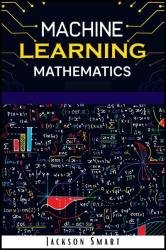Machine Learning Mathematics: Explore Deep Learning Using Data Science. How to Create Artificial Intelligence Using Statistics, Algorithms, Analysis, and Data Mining Concepts (2022 Beginners Guide)
- Добавил: literator
- Дата: 27-12-2021, 19:35
- Комментариев: 0
 Название: Machine Learning Mathematics: Explore Deep Learning Using Data Science. How to Create Artificial Intelligence Using Statistics, Algorithms, Analysis, and Data Mining Concepts (2022 Beginners Guide)
Название: Machine Learning Mathematics: Explore Deep Learning Using Data Science. How to Create Artificial Intelligence Using Statistics, Algorithms, Analysis, and Data Mining Concepts (2022 Beginners Guide)Автор: Jackson Smart
Издательство: Amazon.com Services LLC
Год: 2021
Страниц: 167
Язык: английский
Формат: pdf, azw3, epub
Размер: 10.2 MB
The concept of Artificial Intelligence technology is based on the idea that computers can be programmed to have human-like intelligence.
It can mimic human reasoning and learning abilities, adapting to new inputs and completing tasks without human intervention. The Artificial Intelligence principle includes Machine Learning. Machine Learning Technology (ML) is an Artificial Intelligence philosophy that focuses on computers' designed ability to learn directly and self-train, discover information patterns to improve the underlying algorithm, and make autonomous decisions without human intervention. During his tenure at IBM, Arthur Samuel, a pioneering gaming and artificial intelligence professor, coined the term "machine learning" in 1959. According to Machine Learning theory, modern computers can be trained using specific training data sets that can be easily customized to achieve desired functionality. Machine Learning is guided by a pattern-recognition method in which prior interactions and outcomes are recorded and reviewed in a way that correlates to its current position. Due to the iterative nature of machine learning, computers must be able to adapt to new data without the assistance of a human because they are required to process infinite volumes of data. Statistics, which focuses on making predictions using modern computer tools and technologies, is inextricably linked to machine learning. The study of "mathematical optimization" adds methodologies, theories, and application areas to the field of Machine Learning.
Machine Learning is also known as "predictive analytics when applied to business problems." In Machine Learning, the "target" is known as a "label," whereas in statistics, it is known as a "dependent variable." A "variable" in statistics is referred to as a "feature" in Machine Learning. "Feature creation" is referred to as "transformation" in statistics. Data mining and optimization are also inextricably linked to machine learning technology. There is a lot of overlap between machine learning and data mining techniques, with a lot of overlap. Machine learning aims to make predictions based on the training data's predefined properties. On the other hand, data mining is the process of discovering previously unknown characteristics in massive amounts of data. Machine learning, like data mining, employs data mining approaches through "unsupervised learning algorithms" or as a pre-processing phase to improve the model's prediction accuracy.
Deep learning can be learned through Data Science. Thank you for reading How to Build Artificial Intelligence Using Statistics, Algorithms, Analysis, and Data Mining. The chapters that follow will go over the fundamentals of machine learning algorithms as well as the significance of machine learning in addressing modern business problems. The first chapter of this book contains a detailed description of the four basic types of machine learning algorithms currently available on the market and the significance of machine learning. The three main ideas of machine learning discussed in depth are representation, evaluation, and optimization.
You will be introduced to the concept of "Statistical Learning," which is a descriptive statistics-based machine learning framework that can be classified as supervised or unsupervised. In Chapter 2 of this book, titled "Machine Learning Algorithms," you will learn how to build and apply some of the most common supervised machine learning algorithms, including linear regression, logistic regression, and Nave Bayes classification algorithms. It will provide you with an overarching guide for everything you need to know for successful neural network model development by teaching you how to build data pipelines for your machine learning models and then guiding you through specific neural network training approaches in Chapter 3 titled "Neural Network Learning Models." This chapter's end-to-end procedure will show you how to build your desired machine learning model from the ground up, focusing on neural network models. You'll also learn about the various components and functionalities of the Artificial Neural Network and Perceptron (single neuron-based network) models, as well as how to apply these advanced and future machine learning models to common business problems. In the fourth chapter of this book, "Learning Through Uniform Convergence," we'll dive deep into the intersection of machine learning and statistics. One of many borrowed statistical principles used in creating machine learning models is "Uniform Convergence," which allows the developer to assess the learnability of the problem at hand based on the data sample size using empirical risk minimizers.
Contents:
Скачать Machine Learning Mathematics: Explore Deep Learning Using Data Science. How to Create Artificial Intelligence
[related-news] [/related-news]
Внимание
Уважаемый посетитель, Вы зашли на сайт как незарегистрированный пользователь.
Мы рекомендуем Вам зарегистрироваться либо войти на сайт под своим именем.
Уважаемый посетитель, Вы зашли на сайт как незарегистрированный пользователь.
Мы рекомендуем Вам зарегистрироваться либо войти на сайт под своим именем.

